
PrillyCharmin's
Basic Dress
Pattern Instructions
Designed by PrillyCharmin
Copyright 1999, 2001, 2009 Cynthia Stevens
Instructions for the
Baby Face Pattern, Nicole Pattern, Holly Pattern,
and our new MAGIC-10 Dresses Patterns

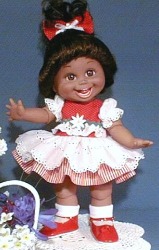 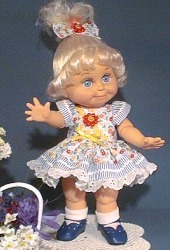 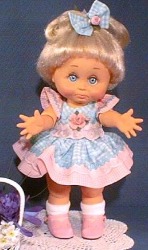 
  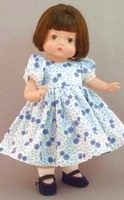   

Basic Dress with Full Skirt
- Dress, with Full
Skirt
- Dress, Full Skirt
with Contrast Border
- Dress, with drop
waist and full skirt
- Sleeve Variations
- Baby Face Diapers
(bottom of this page.)
GETTING STARTED:
READ THIS ENTIRE PAGE. Look
over this entire instruction page before you
start. Instructions on how to cut the skirt are
further down the page. Instructions for Baby Face
Diapers (part of our Baby Face Pattern) are at
the bottom of the page.
TRACE YOUR PATTERN onto the
Fabric. I like to trace the pattern onto
the fabric with pencil, lightly, and cut on the
pencil lines. (On an old video on YouTube, I saw
the seamstresses at Ideal doing the same thing as
they assembled clothing for the 1950's Betsy
Wetsy.)
Dolly clothes are so small that
it's easier to cut out the pieces when they're
traced, rather than try to cut around the paper
pattern pieces. And, it's more accurate.
You don't want to accidentally
make the pieces larger because even a little bit
of extra fabric can affect how it fits the doll.
Tracing the pieces helps you avoid enlarging the
pattern inadvertantly.
BODICE PIECES MUST BE ON THE
FOLD. Make sure your bodice pieces are
snug up on the fold of the fabric when you cut
them out. Otherwise your bodice may end up a lot
wider than you expected (or smaller.) I've had
dresses that were 1 or 2 sizes larger because
they were off the fold by a little bit. Baby Face
dolls are especially hard to fit with their
narrow shoulders, so this makes a big difference.
Any of the smaller sizes will be affected by how
accurately the bodice pattern is placed on the
fold.
SEAM WIDTH. We use a
seam width of approx. 3/16 inch (less than ¼
inch) for small dolly dresses. For our larger
dolls, the seam width is ¼ inch.
MAKE A PRACTICE DRESS FIRST. It is
advisable to make a practice outfit first to see
how the pattern works for you. If your fabric is
something special, then don't risk it. Make a
cotton print dress first so you can see how the
pattern works on your doll. There are thousands
of dolls in thousands of individual shapes, so
the pattern will most likely need a little
tweaking in order to be perfect.
STEP 1: BODICE ASSEMBLY
As with all my dresses and shirts
for dolls, I make the top or bodice with double
fabric so it is fully lined front and back (no
messing with facings or interfacings this way.)

Stitch the front pieces to the
back pieces at the shoulders. All four pieces
will be connected at the shoulders (front, back,
front, back alternating) and then press the
shoulder seams flat.
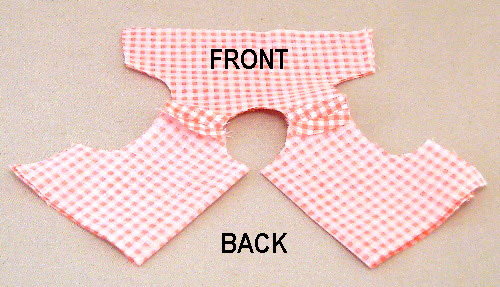
Next, bring the right sides of
the fronts together. As you do this, the back
pieces will naturally need to fold in half. The
bodice opens in the back.
Stitch
all the way around the neck. Clip the curves.
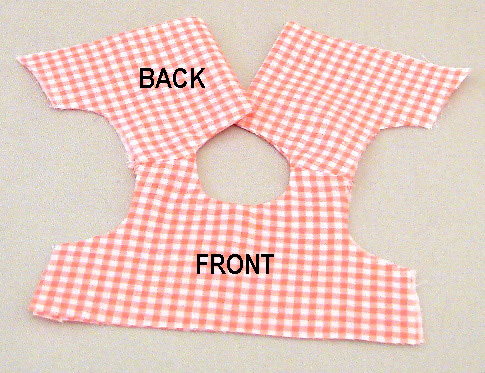
Then
turn the pieces right side out and press the
bodice flat.
ADJUSTMENTS: TRY
THE BODICE ON THE DOLL TO SEE IF THE NECK FITS
PROPERLY. This is the time to adjust the neckline
if necessary. Some dolls have a very fat neck
(infant dolls), so if you need to enlarge the
neck hole it needs to be done now. If the neck is
too small, turn the bodice inside out again and
adjust the neck hole as needed to make it larger.
You won't be able to adjust the
neckline after this point.

VARIATIONS. You
may insert lace, rickrack, ruffles or a
collar in the neck to dress it up. This
should be done while stitching the neck
hole. This photo shows rickrack edging,
for an old fashioned look.
STEP 2: SLEEVES
Choose which sleeve you want.
Puffed sleeve, butterfly cap sleeve, plain short
sleeve or vintage style bubble sleeve.
You may add some rickrack or
other trim to the sleeves.
All of the sleeves need to be
gathered at the top, including the plain sleeve.
The plain sleeve
doesn't need to be gathered much but you do need
to draw some of the fullness in.
No matter which sleeve you use,
try to arrange most of the gathers near the top.
The sleeve will look better that way.
Gather the top edge of the
sleeves and attach to bodice armholes. Be sure to
match the center top of the sleeve with the
shoulder seam.
BUTTERFLY SLEEVE:
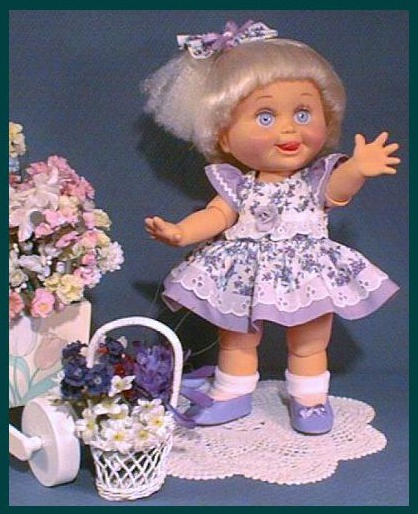
The butterfly sleeve
is a cap sleeve. Does not need hemming: it is a
double fabric sleeve and is sort of like a
ruffle. No elastic on the butterfly sleeve. You
may add lace and trims to the sleeve as desired.
BUBBLE SLEEVE:
 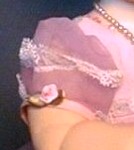  
Here are four photos of our
unique Bubble sleeve (in various sizes.) The
Bubble sleeve was inspired by antique doll
clothing. This is a puffed sleeve that does not
require elastic: it fits smoothly around the arm
of the doll, while the top of it is gathered into
a puff sleeve. Elastic tends to stretch out, so
we highly recommend using this bubble sleeve
pattern on doll dresses instead of the puffed
sleeves that need elastic.
You may finish the lower edge of
the bubble sleeve with bias tape, lace, rickrack
or other trims. You can also decorate the sleeve
with rosettes or ribbons.
Gather the top (rounded) edge of
the bubble sleeve, making note where the center
is so you can match it to the shoulder seam. Then
sew the sleeves to the bodice.
If you want the Bubble Sleeve to
be more poofy (or less poofy), you may use a
larger (or smaller) sleeve pattern. The MAGIC-10
pattern has 10 sizes, so you can use a larger
sleeve if you want more volume.
The Bubble Sleeve is included
with our MAGIC-10 doll dress pattern.
STEP 3: FINISH THE BODICE
Before you stitch the side seams,
you can add lace or trims to the front of it.
What you do with the front of your dress is what
will (most likely) make it very special and cute.
Here are some examples:
 
Left: rickrack and eyelet lace.
Right: two rows of pintucks.
 
Left: rounded faux cummerbund
with fancy lace and trims.
Right: rounded faux cummerbund with matching bias
tape on sleeves.
After you have decorated the
front, it is time to stitch the side seams of the
bodice. You will sew the side seam on the sleeve
at the same time.
Next, put the bodice on the doll
to see how it fits. THIS IS THE TIME TO ADJUST
IT. If the bodice fits properly, the dress will
look more professional and less like a homemade
gown.
It's very easy to make
adjustments to our Dress patterns, because the
side seams are the key to good fit. So check the
FIT now. It's easy to adjust the side seam at
this point. After the skirt is attached, it's too
late.
When you are satisfied with how
the bodice fits, then finish the seam edges.
Sew velcro or snaps to the back
opening. Or, you could make tiny buttonholes with
buttons if there is enough overlap. (Some people
may prefer to add the velcro last, after the
skirt is attached.)
The bodice is finished.

VARIATIONS. This
dress was originally made to fit our 18 inch Gotz
American Girl type doll, but the bodice was way
too long for this Marx First Love babydoll. The
babies do look better with a short bodice.
So we shortened it up by
stitching two rows of 1/4 inch pintucks. We
folded the bodice all the way across (front and
back), ironed it and stitched it at 1/4 inch.
Then folded it again, ironed it flat and stitched
the second row of pintucks. Then ironed the
pintucks flat again, when finished.
Not only do the pintucks look
cute, but the bodice is much shorter now. Of
course, we could have cut the bodice shorter, but
pintucks was more fun.
Also, notice that the right side
sleeve is too big around the arm. The lace gaps.
The bubble sleeve is very easy to adjust. Just
take it in a little under the arm. Only be
careful to leave enough room for the hand to fit
through.
STEP FOUR: CUTTING THE SKIRT
PIECE
Our pattern gives a general guide
for cutting the skirt piece but the length is up
to you, and depends on 1.) the height of the doll
2.) whether you want a long skirt or a short
skirt. 3.) whether you intend to finish the hem
with lace edging or you plan to turn back the
fabric and hem it. So these are decisions and
adjustments you need to make.
WIDTH of the
skirt fabric... If I'm using cotton prints, I use
the entire width of the fabric, which is 45
inches most of the time. For small dolls, there
will be some leftover but it's not that much. For
tall dolls such as the 18 inch American Girl or
Magic Attic dolls, the full width of the fabric
is just about right because you don't want as
much fullness for the pre-teen dolls.

The large sitting babydolls need
more fabric in their skirt, so it will fan out
around them. I use TWO pieces, the full width of
the fabric. Cut one piece in half and use it for
the back of the skirt: you don't want the front
of the skirt to have any seams. Seams should be
at the sides and center back, as shown in this
drawing:

Adjust for thin fabrics. If your
fabric is very thin, you may need to double the
amount of fabric in the skirt. We tested our
dress patterns using medium weight quilter's
cotton print fabrics. But if your fabric is
lightweight, such as cotton voile, you will need
approximately twice as much fabric in the skirt
width, in order to get the appropriate fullness.
If you are using very lightweight
fabric such as batiste, you may need to triple
the width of fabric in the skirt.
STEP FOUR: ASSEMBLE THE SKIRT
Add lace and ribbon trims to the
full skirt, if desired.
With larger dolls, you may want
to stitch the skirt closed part of the way in
back, so the dress is STEP-IN style.
For smaller dolls, we prefer to
leave the back open because it's easier to put
the dress on. The full skirt overlaps so it is
still very modest and doesn't need to be stitched
shut. Turn and stitch both ends of the skirt for
a neat edge on both ends.
Gather the top edge of the skirt
and attach to bodice.
Fold and stitch the hem of the
skirt or add lace to edge it.
Dress is Finished.
STEP FOUR: SKIRT VARIATION
Contrast Border. Fold the
contrast border in half lengthwise and press it.
Stitch to the upper skirt piece lengthwise.
Press. (Lace and ribbon trims may be added as
desired.

Diapers for Baby Face Dolls
Designed by PrillyCharmin for Baby Face Dolls
Copyright 1999, 2001 Cynthia Stevens
1 - Unpadded Cloth Diaper with
Velcro
Cut 2 Pieces
The lining
fabric can be of white flannel or
flannel knit if desired.
Stitch right
sides together leaving approximately
two inches at the back waist open.
Clip to the
seam all the way around the diaper so
the seams will lay flat when turned.
Turn right
side out and topstitch the opening
closed. Press with iron.
Stitch
velcro where indicated.
2 - Vinyl Diaper with Velcro
Use flannel
backed vinyl tablecloth fabric
Cut 1 Piece
ZigZag or
Serge around the entire edge
Stitch
velcro where indicated
|